Related Research Articles

The Kalahari Desert is a large semi-arid sandy savanna in Southern Africa extending for 900,000 square kilometres (350,000 sq mi), covering much of Botswana, as well as parts of Namibia and South Africa.

At 824,292 km2 (318,261 sq mi), Namibia is the world's thirty-fourth largest country. After Mongolia, Namibia is the second least densely populated country in the world. Namibia got its name from the Namib desert that stretches along the coast of the Atlantic. It is also known for its wildlife.

The Gods Must Be Crazy is a 1980 comedy film written, produced, edited and directed by Jamie Uys. An international co-production of South Africa and Botswana, it is the first film in The Gods Must Be Crazy series. Set in Southern Africa, the film stars Namibian San farmer Nǃxau ǂToma as Xi, a hunter-gatherer of the Kalahari Desert whose tribe discovers a glass Coca-Cola bottle dropped from an aeroplane, and believe it to be a gift from their gods. When Xi sets out to return the bottle to the gods, his journey becomes intertwined with that of a biologist, a newly hired village school teacher, and a band of guerrilla terrorists.

The San peoples, or Bushmen, are the members of the indigenous hunter-gatherer cultures of southern Africa, and the oldest surviving cultures of the region. Their ancestral territories span Botswana, Namibia, Angola, Zambia, Zimbabwe, Lesotho and South Africa. They speak, or their ancestors spoke, languages of the Khoe, Tuu and Kxʼa language families, and are only a 'people' in contrast to pastoralists such as the Khoekhoe and descendants of more recent waves of immigration such as the Bantu, Europeans and Asians.
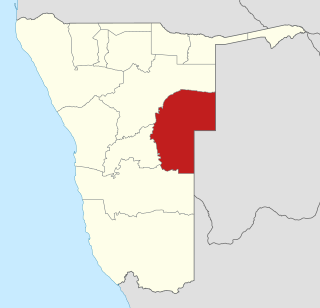
Omaheke is one of the fourteen regions of Namibia, the least populous region. Its capital is Gobabis. It lies in eastern Namibia on the border with Botswana and is the western extension of the Kalahari desert. The self-governed villages of Otjinene, Leonardville and Witvlei are situated in the region. As of 2020, Omaheke had 48,594 registered voters.

The brown hyena, also called strandwolf, is a species of hyena found in Namibia, Botswana, western and southern Zimbabwe, southern Mozambique and South Africa. It is the only extant species in the genus Parahyaena. It is currently the rarest species of hyena. The largest remaining brown hyena population is located in the southern Kalahari Desert and coastal areas in Southwest Africa. The global population of brown hyena is estimated by IUCN at a number between 4,000 and 10,000 and its conservation status is marked as near threatened in the IUCN Red List.

Kgalagadi Transfrontier Park is a large wildlife preserve and conservation area in southern Africa.

The gemsbok or South African oryx is a large antelope in the genus Oryx. It is native to the extremely dry, arid regions of Southern Africa; notably, the Kalahari and Namib Desert. Some authorities formerly classified the East African oryx as a subspecies.

Ghanzi is a town in the middle of the Kalahari Desert the western part of the Republic of Botswana in southern Africa. The region is the country's pride in contributing a large portion towards the beef industry. In fact, Ghanzi farmers provide about 75% percent of beef exports, according to the Botswana Meat Commission, primarily to the United Kingdom and the European Union.

Roy Sesana is a San activist who worked together with the First People of the Kalahari for the rights of his people.


Meerkat Manor is a British television programme produced by Oxford Scientific Films that premiered in September 2005. Originally broadcast on Animal Planet International for four seasons, until its cancellation in August 2008, the programme had a revival in 2021 with the programme now known as Meerkat Manor: Rise of the Dynasty in some countries. Using traditional animal documentary style footage along with narration, the series told the story of the Whiskers, one of more than a dozen families of meerkats in the Kalahari Desert being studied as part of the Kalahari Meerkat Project, a long-term field study into the ecological causes and evolutionary consequences of the cooperative nature of meerkats. The original programme was narrated by Bill Nighy, with the narration redubbed by Mike Goldman for the Australian airings and Sean Astin for the American broadcasts. The fourth series, subtitled The Next Generation, saw Stockard Channing replacing Astin as the narrator in the American dubbing. In 2021, Nighy could be heard narrating the new series of Meerkat Manor when it was broadcast in the United States on BBC America and on Channel 5 in the United Kingdom, making it the first time that both television markets have used the same voice over on the programme.
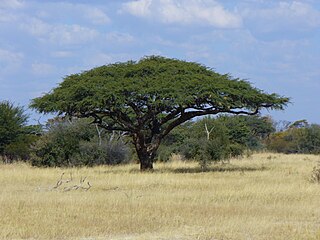
Vachellia erioloba, the camel thorn, also known as the giraffe thorn, mokala tree, or Kameeldoring in Afrikaans, still more commonly known as Acacia erioloba, is a tree of southern Africa in the family Fabaceae. Its preferred habitat is the deep dry sandy soils in parts of South Africa, Botswana, the western areas of Zimbabwe and Namibia. It is also native to Angola, south-west Mozambique, Zambia and Eswatini. The tree was first described by Ernst Heinrich Friedrich Meyer and Johann Franz Drège in 1836. The camel thorn is a protected tree in South Africa.

Khaudum National Park is an isolated Nature Reserve situated in the Kalahari Desert to the west of the Caprivi Strip in the northeast of Namibia. It is a very remote and inaccessible reserve, but is home to some magnificent animals, such as the lion and hyena. The park also has a campsite for visitors.

Kalahari Resorts and Conventions is a water park resort chain with locations in Wisconsin Dells, Wisconsin; Sandusky, Ohio; Pocono Manor, Pennsylvania; and in Round Rock, Texas. Named for the Kalahari Desert in southern Africa, the resorts are heavily decorated with African animals, plants, and other African motifs.
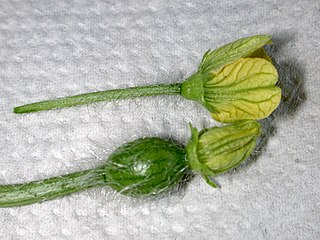
Watermelon seed oil is extracted by pressing from the seeds of the Citrullus lanatus (watermelon). It is particularly common in West Africa, where it is also called ootanga oil.

The serrated tortoise German: Kalahari-Strahlenschildkröte is a species of tortoise that occurs in the Kalahari desert regions of southern Africa. Also known as the Kalahari tent tortoise, it is one of three members of the genus, Psammobates.
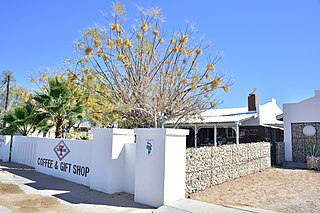
Askham is a village in the Dawid Kruiper Local Municipality in the ZF Mgcawu District Municipality in the Northern Cape province of South Africa. Askham lies not far from the confluence of the mostly dry Molopo and Kuruman Rivers in the Red Kalahari Desert, about 200 km north of Upington at the junction of the R31 and the R360 roads.
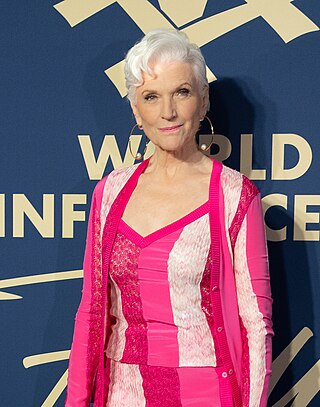
Maye Musk is a model and dietitian. She has been a model for 50 years, appearing on the covers of magazines, including a Time magazine health edition, Women's Day, international editions of Vogue, and Sports Illustrated Swimsuit Issue. She is the mother of Elon Musk, Kimbal Musk and Tosca Musk. She holds Canadian, South African, and American citizenship. She is a registered dietitian.
References
- ↑ George B. Silberbauer (April 30, 1981). Hunter and Habitat in the Central Kalahari Desert. ISBN 9780521281355 . Retrieved April 19, 2019.
- ↑ "High Pressure". Laulima.hawaii.edu. Retrieved 2013-10-12.
- ↑ "Global circulation". St-andrews.ac.uk. 2000-11-14. Retrieved 2013-10-12.
